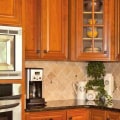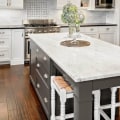Choosing between white or off-white kitchen cabinets is a significant decision that can influence the overall look and feel of your kitchen. Both color options offer a range of benefits and potential drawbacks, making it essential to weigh the pros and cons before making a final choice. White kitchen cabinets are a classic choice, celebrated for their timeless appeal and versatility. They can create a bright, clean, and spacious feel, making even small kitchens appear larger and more open. White cabinets reflect light effectively, which can be particularly beneficial in kitchens with limited natural light. This brightness can create an inviting atmosphere and can easily complement various design styles, from traditional to modern.
One of the primary advantages of white kitchen cabinets is their ability to pair seamlessly with other colors and materials. Whether you have a vibrant backsplash, colorful walls, or bold countertops, white cabinets can balance the overall aesthetic without clashing. They also provide a neutral backdrop that allows other elements of the kitchen, such as kitchen sinks, appliances, and decorative accessories, to stand out. This flexibility makes white cabinets a popular choice for homeowners who may want to change their kitchen’s color scheme or decor over time without the need to replace the cabinetry.
However, white kitchen cabinets are not without their disadvantages. One of the most significant concerns is their susceptibility to showing dirt, stains, and wear more readily than darker colors. Grease splatters, fingerprints, and food stains can become more noticeable on white surfaces, requiring more frequent cleaning to maintain their pristine appearance. This high maintenance aspect can be a drawback for busy households or those with young children. Additionally, over time, white cabinets can yellow or discolor due to exposure to sunlight and cooking fumes, which may necessitate periodic touch-ups or repainting to keep them looking fresh.
Off-white kitchen cabinets, on the other hand, offer a subtle alternative that combines the brightness of white with a warmer, more inviting tone. Off-white shades can include creamy, beige, or slightly tinted hues that add depth and character to the kitchen. These cabinets can provide a softer look that still enhances the perception of space and light but with a less stark and more welcoming feel. Off-white cabinets are particularly well-suited to traditional, rustic, or farmhouse-style kitchens, where they can complement natural materials like wood and stone.
One of the pros of off-white kitchen cabinets is their ability to hide dirt and imperfections more effectively than pure white. The slight tint can mask minor stains and smudges, reducing the need for constant cleaning. This can be a significant advantage for households with children or frequent kitchen activity. Additionally, the warmer tones of off-white can create a cozy and comfortable atmosphere, making the kitchen a more inviting space for family gatherings and entertaining guests.
However, off-white cabinets also have their drawbacks. The primary concern is that they may not achieve the same level of brightness and contemporary look as pure white cabinets. In kitchens with limited natural light, off-white cabinets might not reflect light as effectively, potentially making the space feel slightly darker or less open. Furthermore, the specific shade of off-white chosen can impact the overall aesthetic, requiring careful consideration to ensure it complements other elements in the kitchen. For instance, some off-white tones may clash with certain wall colors or countertop materials, necessitating a more thoughtful design approach.
Another potential downside of off-white cabinets is the difficulty in achieving a consistent look. Because off-white encompasses a range of shades, matching new cabinetry with existing elements can be challenging. Variations in paint batches or finishes can result in slight color differences that might be noticeable and detract from the overall cohesiveness of the kitchen design.
Ultimately, the choice between white and off-white kitchen cabinets depends on personal preference, lifestyle, and the specific characteristics of your kitchen space. White cabinets offer a timeless, versatile, and bright option that can make a significant visual impact but require more maintenance to keep them looking clean and fresh. Off-white cabinets provide a warmer, more forgiving alternative that can create a cozy atmosphere and hide imperfections better but may not offer the same level of brightness and may require more careful coordination with other design elements. Whether you opt for the crisp, clean look of white or the soft, inviting appeal of off-white, both options can enhance the beauty and functionality of your kitchen, providing a stylish backdrop for your culinary activities and gatherings.


